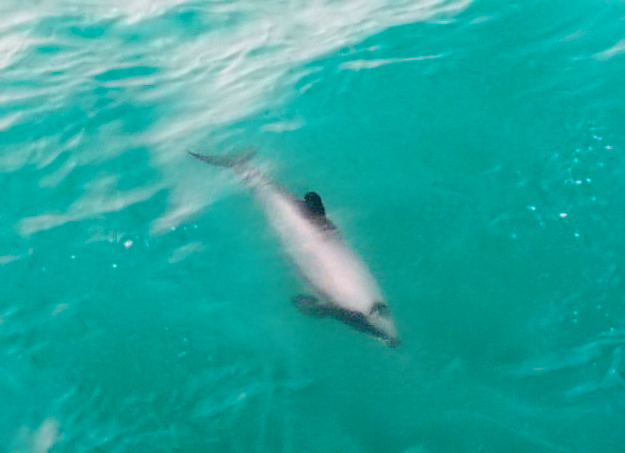| 새로운 사진 | 신문속의 동물소식 | 신기한 동물이야기 | 동물의 소리 | 동물동화상 | 사진 올리기 | 사진 저작권 | English |
|---|
| 재미있는 동물사진 | 괴수/괴어/엽기 동물사진 | 동물이름사전 | 동물목록 | 바깥고리 | 창고입구 | 똑똑누리집 |
|---|
| 이미지 정보 | Original File Name: Hectors_delfin-Hector\'s white-headed Dolphin (Cephalorhynchus hectori).jpg Resolution: 625x453 File Size: 158777 Bytes Date: 2005:09:30 14:59:06 Upload Time: 2007:09:24 03:50:52 | |
| 올린이 | 이름 (메일주소): Unknown | |
| 사진 제목 | Hector's Dolphin (Cephalorhynchus hectori) - Wiki | |
 |
| Email : 카드 | 올린이 | 운영자 사진삭제 정보수정 Admin |
| 설명 | Hector's Dolphin (Cephalorhynchus hectori) - Wiki
Hector's Dolphin
Hector's Dolphin or White-headed Dolphin (Cephalorhynchus hectori) is the most well-known of the four dolphins in the genus Cephalorhynchus. At about 1.4 m in length, it is one of the smallest cetaceans. Hector’s dolphin was named after Sir James Hector (1834-1907). He was the curator of the Colonial Museum in Wellington (now the Museum of New Zealand - Te Papa). He examined the first specimen found of the dolphin. Popoto/Maui's Dolphin (Cephalorhynchus hectori maui) is a subspecies found off the northwest coast of New Zealand's North Island. It is the most endangered subspecies of all marine mammals (other cetaceans with a similarly perilous conservation status inhabit rivers and estuaries only). There are approximately 110 Maui's dolphins in the wild, with only 25 of those estimated to be breeding females. The Maui's dolphin is critically endangered due to being caught in fishing nets and being wounded by boat. Adult Maui's dolphins are generally 1.2 to 1.6 m long and weigh upto 50 kg. They have a rounded dorsal (upper) fin and have white undersides and grey sides. Maui's dolphins take short (90 second) dives to feed on small fish and crustaceans on the ocean floor.
Hector's dolphin has no discernible beak and a rounded dorsal fin. The fluke has pointed tips and concave trailing edges. The overall color is a pale grey but closer inspection reveals a complex tapestry of colour. The forehead is grey with streaks of black. The tip of the beak is black. The throat and chest are white. Above that there is a dark grey patch running from the flippers (also dark grey) to the eyes. The belly is also white with a stripe running up the sides from under the dorsal fin. The bulk of the back and sides is the same lighter grey of the beak. The tail stock is narrow. At birth the animal weighs about 9 kg and grows to about 40 to 60 kg at adulthood. They live for about 20 years. Hector's dolphins live in fluid groups of about two to eight in number. They are active animals, readily bow-riding and playing with seaweed. When leaping from the sea, individuals will often land on their side, creating a loud splash (their vertical and horizontal dives are much less noisy). Some sharks prey on Hector's Dolphins. Population and distribution Hector's dolphins are endemic to the coastal regions of New Zealand. There are two known main populations, one on each side of the South Island. The two populations are believed to be largely cut off from one another by deep water at Cook Strait and at the south-west tip of the South Island. The species seems unwilling or unable to cross areas of deep water. The total population was estimated to be around 3,500 in the mid-1980s. A more recent survey suggested a total population of approximately 7,250 individuals (see conservation below). A notable population exists at Akaroa, near Christchurch, New Zealand. Hector's Dolphins are sighted always less than 10 km off-shore in summer and only slightly further afield in winter. Occasional sightings were reported from Australia and Malaysia, but these were mis-identifications. There are about 100 individuals in the Maui subspecies. Conservation Entanglement in gillnets is a very significant threat to the Hector's dolphin species. From 1970 such entanglements, which lead to certain death, are estimated to be responsible for reducing the population. In 1988 a marine reserve was created around Banks Peninsula to prohibit gillnet activity in the area. This has stemmed the rate of population decrease, but an increase in numbers has not yet been recorded. Other threats, such as collisions with boat propellers, may also be hampering a return to stability. In March 2004, New Zealand's Department of Conservation began testing a system for satellite tracking cetaceans by tagging three Hector's Dolphins. If these movements can be tracked successfully, the system will be extended to track the highly endangered Maui subspecies. In April 2007, the World Wide Fund for Nature launched an online petition asking Helen Clark to introduce emergency measures to protect the Hector's and Maui dolphins. http://en.wikipedia.org/wiki/Hector's_Dolphin
| |||
| 저작권 정보 | 사진의 저작권은 원저작자에게 있습니다. 동물그림창고는 동물관련 사진을 전시할 수 있는 공간만을 제공합니다.사진을 사용하고자 할 경우에는 저작권자와 협의하시기 바랍니다. |
|
|
|
| |||||||
| CopyLeft © since 1995, 동물그림창고. All rights may be reserved. | ||||||||
Stats